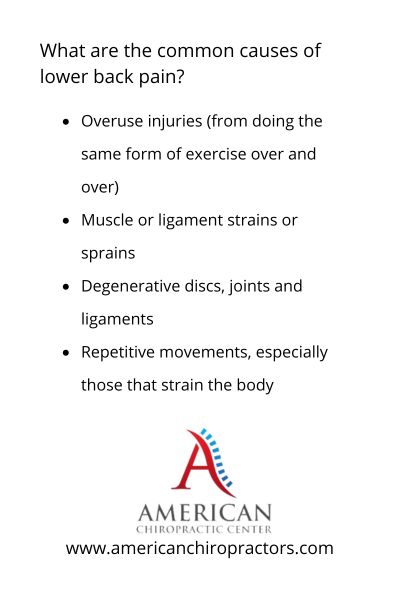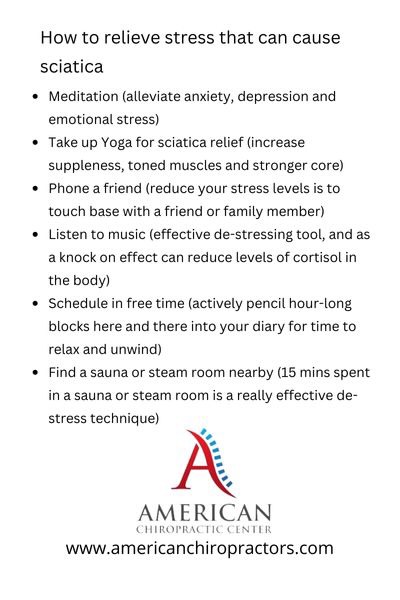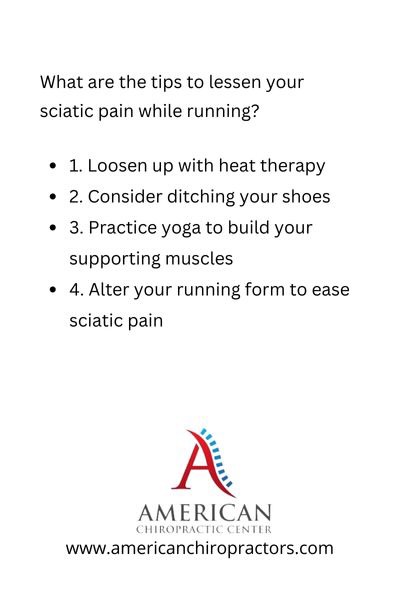Back Pain
How Does Regular Exercise Help Alleviate Lower Back Pain?

Regular exercise helps alleviate lower back pain by strengthening core muscles, improving flexibility, promoting healthy weight management, enhancing posture, releasing endorphins for pain relief, and improving joint health.
Read more about How Does Regular Exercise Help Alleviate Lower Back Pain

Tailoring an exercise routine with a mix of cardiovascular, strength, and flexibility exercises is for effective pain relief, requiring consultation with a healthcare professional for personalized guidance.
More about How Does Regular Exercise Help Alleviate Lower Back Pain
Understanding Lower Back Pain
Lack of muscle strength and flexibility, along with inadequate exercise, can contribute to chronic low back pain. When the muscles supporting the spine are weak or tight, it can lead to strain on the lower back, causing pain and discomfort. Inadequate physical activity and poor posture also play a significant role in the development of lower back pain.
Understanding the importance of maintaining muscle strength and flexibility through appropriate exercises is for preventing and alleviating chronic low back pain. Regular exercise targeting the core abdominal muscles and incorporating flexibility exercises can help improve lower back pain over time.
The Connection Between Physical Activity and Pain Relief
Physical activity helps by increasing blood flow to the affected area, promoting healing, and releasing endorphins, which are natural pain relievers. Through consistent exercise, you can build strength in your core muscles, providing better support for your spine and reducing the risk of future pain episodes.
By engaging in physical activities such as strength training and flexibility exercises, you can improve your muscular strength and promote flexible muscles. Strengthening the muscles surrounding your lower back helps to provide better support and stability to the spine, reducing the risk of pain and discomfort.
The Psychological Benefits of Exercise for Pain Management
Engaging in regular physical activity can contribute to pain reduction by releasing endorphins, which are natural painkillers produced by the body. These endorphins can help alleviate discomfort and improve your mood, reducing depressive symptoms often associated with chronic pain conditions.
Exercise has been shown to improve your quality of life by promoting better sleep, reducing stress, and boosting self-esteem. By incorporating exercise into your routine, you not only strengthen your body but also empower your mind to better cope with pain, ultimately leading to a more balanced and fulfilling life.
Stretching Exercises
To effectively target lower back pain, incorporating specific stretching exercises into your routine can provide much-needed relief and promote flexibility. Stretching helps alleviate tension in the muscles supporting the spine, reducing the risk of injury and enhancing mobility.
Here are three beneficial stretching exercises for low back pain:
- Hamstring Stretch: This stretch involves sitting on the floor with one leg muscles extended and the other bent. Reach towards the extended foot to stretch the hamstrings.
- Child’s Pose: Kneel on the floor, then sit back on your heels while stretching your arms forward. This pose helps elongate the lower back muscles.
- Piriformis Stretch: Lie on your back, cross one ankle over the opposite knee, and gently pull the lower knee towards the chest to stretch the piriformis muscle.
Strength Training Exercises
Incorporating strength training exercises targeted at the lower back can further improve your efforts in relieving pain and improving back health.
When focusing on muscle strengthening your back through resistance back exercises, consider the following:
- Superman Exercise: Lie face down, lift your arms and legs off the ground simultaneously, engaging your lower back muscles.
- Bridge Exercise: Lie on your back, knees bent, and lift your hips off the ground, activating your glutes and lower back.
- Deadlifts: Perform with proper form, lifting weights from the ground while engaging your core and back muscles.
Aerobic Exercises
When targeting lower back pain, consider incorporating specific aerobic exercises to enhance your back health and alleviate discomfort. Aerobic exercises are beneficial for back pain relief as they help strengthen the muscles that support your spine and improve flexibility.
Here are three key aerobic exercises that can contribute to alleviating lower back pain:
- Walking: A low-impact aerobic exercise that can improve circulation, strengthen core muscles, and reduce stiffness in the back.
- Swimming: Water provides resistance while being gentle on the back, making it an excellent choice for improving fitness and reducing back pain.
- Cycling: Riding a stationary bike or cycling outdoors can help increase blood flow to the spine, enhance flexibility, and strengthen back muscles, promoting better back health.
The Impact of Exercise on Musculoskeletal Health
Exercises that target the core, back, and hip flexors muscles, you enhance your body’s ability to maintain proper alignment and support the spine’s natural curvature. Stronger muscles also help absorb shock and stress during daily activities, easing the burden on your lower back.
Exercise promotes better circulation, delivering essential nutrients and oxygen to the muscles, which aids in their recovery and musculoskeletal health.
The Role of Exercise in Reducing Inflammation
As you maintain a consistent workout routine, your body’s engagement in physical activity plays a critical role in reducing inflammation associated with chronic back pain lasts. Exercise helps lower back pain by reducing inflammation in the affected area.
When you engage in physical activity, it triggers the release of anti-inflammatory molecules that target the inflamed soft tissues in your lower back. This process helps to alleviate pain and discomfort while promoting healing.
Regular exercise also improves blood circulation, delivering essential nutrients and oxygen to the affected area, further aiding in reducing inflammation.
Safety Measures and Precautions
Before beginning any exercise routine for acute back pain, understand when to avoid certain movements that could exacerbate your condition.
Focus on maintaining proper form and technique during each exercise to prevent further strain on your lower back.
Always seek guidance from a healthcare professional before starting any new exercise program to confirm it aligns with your specific needs and limitations.
When to Avoid Exercise with Lower Back Pain
To ensure your safety and prevent further aggravation of your lower back pain, be mindful of certain precautions and know when to avoid specific exercises.
Maintaining proper posture during workouts is important to prevent straining your lower back. Avoid exercises that involve lifting heavy weights, as this can place excessive stress on your back muscles. If you experience sharp pain or discomfort while exercising, stop immediately and seek medical attention.
Certain activities like high-impact exercises or those that involve twisting motions may exacerbate your lower back pain worse and should be avoided. Listening to your upper body and being cautious with your exercise choices can help prevent worsening of your condition.
Importance of Proper Form and Technique
When performing exercises such as squats, deadlifts, or overhead presses, make sure your lumbar spine is in a neutral starting position, and avoid rounding your back. Engage your core muscles to provide support and stability to your lower back. Focus on using controlled movements to avoid sudden jerks or twists that could lead to injury.
Consulting with a Healthcare Professional Before Starting an Exercise Regimen
When considering starting an exercise regimen, consult with a healthcare professional to make sure safety measures and precautions are taken into account. A healthcare professional can provide personalized guidance based on your specific health conditions, ensuring that the exercise regimen is safe and effective for you.
Addressing Fears and Concerns About Exercise and Back Pain
Addressing fears and concerns about exercise and back pain requires understanding the myths and misconceptions surrounding the relationship between physical activity and lower back pain. One common misconception is that exercise will worsen back pain. In reality, tailored exercise routines can strengthen the muscles supporting your spine, reducing the risk of future pain.
Another fear is that any movement may lead to injury, but with proper guidance and low-impact activities, exercise can be safe and beneficial. Concerns about not knowing which exercises are suitable for back pain are valid, but consulting a healthcare professional or a qualified trainer can help you find the right exercises for your condition.
Developing a Regular Exercise Routine
When starting to develop a regular exercise routine to alleviate lower back pain, remember to incorporate exercise into your daily life gradually. Set realistic goals for both exercise and pain management, ensuring you don’t push yourself too hard too soon.
Consistency is key in achieving long-term pain relief through exercise.
Tips for Incorporating Exercise into Daily Life
Developing a regular exercise routine can greatly improve your health and help alleviate lower back pain. Exercise promotes better blood flow, which is for nourishing the spinal discs and keeping them healthy.
For individuals suffering from chronic low back pain, incorporating daily physical activity can provide significant relief. To make exercise a part of your daily life, start by choosing activities you enjoy, such as walking, swimming, or yoga. Schedule specific times for your workouts to create consistency.
Remember to start slowly and gradually increase the intensity to avoid injury. By making exercise a priority and integrating it into your routine, you can experience the benefits of reduced lower back pain and improved well-being.
Setting Realistic Goals for Exercise and Pain Management
To effectively manage your lower back pain through exercise, it’s important to set realistic goals that align with your aerobic fitness level and pain tolerance. Start by consulting with a healthcare professional or a physical therapist to determine suitable exercises for your condition.
When setting goals, consider factors like frequency, intensity, and duration of exercise sessions. Begin with achievable targets, such as brisk walking for 20 minutes a day or doing gentle stretching exercises. Gradually increase the difficulty as your strength and endurance improve.
The Role of Consistency in Achieving Pain Relief
Regular exercise helps strengthen the muscles supporting your spine, improving posture, and reducing the risk of future pain episodes. By maintaining consistency in your exercise routine, you allow your body to adapt and strengthen over time, leading to better pain management outcomes.
Skipping workouts or being inconsistent can hinder progress and prolong the time it takes to experience relief from lower back pain. So, make it a priority to stay committed to your exercise regimen to get all the benefits and effectively manage your lower back pain.
Frequently Asked Questions
Can Regular Exercise Worsen Lower Back Pain if Done Incorrectly?
Regular exercise can indeed worsen lower back pain if done incorrectly. To maintain proper form, avoid overexertion, and listen to your body’s signals. Consulting a healthcare provider or a fitness professional can help prevent exacerbating the pain.
Are There Certain Types of Exercise Equipment or Machines That Should Be Avoided for Lower Back Pain Relief?
Avoid high-impact equipment like rowing machines and leg presses for lower back pain relief. These can strain your back. Opt for low-impact options like ellipticals or stationary bikes. Consult a fitness professional before starting any new exercise routine.
How Long Does It Typically Take to See Improvement in Lower Back Pain With Regular Exercise?
You may start feeling relief from lower back pain within a few weeks of starting regular exercise. Consistency is key. Listen to your body, progress gradually, and consult a healthcare provider for personalized guidance.
Are There Any Specific Dietary Recommendations to Complement an Exercise Routine for Lower Back Pain?
To complement your exercise routine for lower back pain, focus on a balanced diet rich in fruits, vegetables, lean proteins, and whole grains. Hydrate well and consider anti-inflammatory foods like fatty fish, nuts, and seeds.
Can Stretching Alone Be Effective in Alleviating Lower Back Pain, or Is a Combination of Stretching and Strengthening Exercises Necessary?
Stretching alone may provide some relief for lower back pain, but combining it with strengthening exercises is often more effective. Strengthening supports your back, improves flexibility, and reduces the risk of future pain.

We understand how important it is to choose a chiropractor that is right for you. It is our belief that educating our patients is a very important part of the success we see in our offices.






















